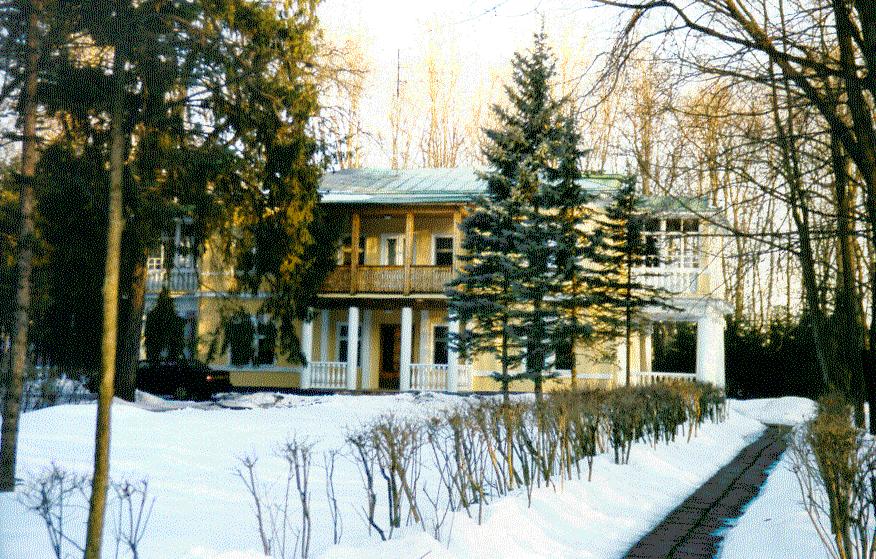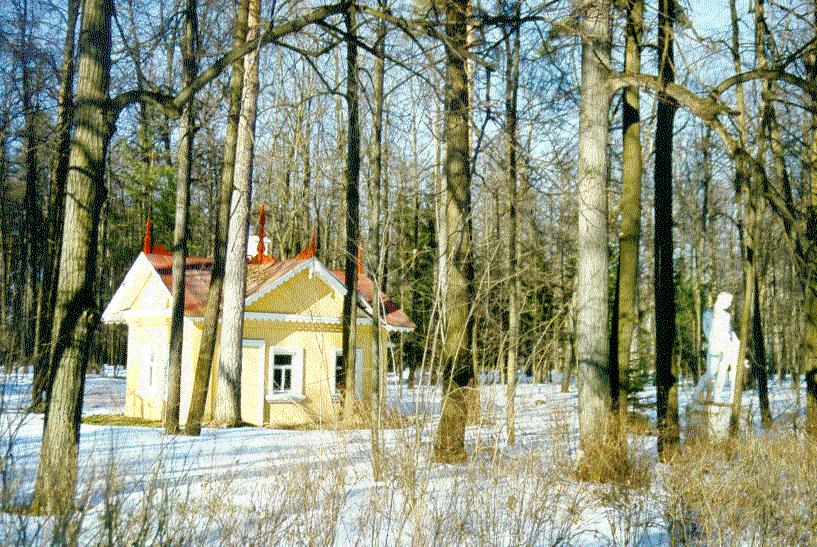![]()
The first written references of Ilyinskoye date back to the 17th century, but it was actually claimed as territory belonging to Russian Tsars in the 16th century. The name Ilyinskoye was derived from the Prophet Ilya, a main prophet of the Old Testament, and to honor him, a small wooden chapel was built in the 16th century at the cite of the present day church.
In 1618, the territory of Ilyinskoye became involved in a Polish- Russian military skirmish and subsequently the chapel and surrounding estate fell in decay. This resulted in the property of Ilyinskoye being transferred to the boyars Morozov.
In 1634, Ilyinskoye was granted to a nobleman. V.I. Streshnyov, who had gained much of his status through the marriage of his daughter, Yevdokiya in 1626 to Tsar Mikhail Fyodorovich, the first of the Romanov dynasty. At that time, the territory became known as the Tsar's Village.
After the death of V.I. Streshnyov in 1661, Semyon Streshnyov, brother of Yevdokiya, became the owner of the estate. He took part in two successful military campaigns, one against Poland which resulted in the consolidation of Belarus, and the other against Sweden. Semyon Streshnyov died in 1666 and was buried in Chudov Monastery in the Kremlin.
The property of Ilyinskoye was then transferred to Rodion Streshnyov, who played an important role in the destiny of the Russian state with participation in Polish-Lithuanian military campaigns and negotiations. The estate was under his ownership for 21 years and upon his death in 1687, he was also buried in Chudov Monastery.
Ivan Streshnyov, Rodion's son, then became the owner of the Ilyinskoye estate. As a child, he took part in games with Peter the Great and later when Peter became Tsar, Ivan participated in the foundation of the first poteshny regiment. In 1719, Ivan settled in St. Petersburg where he died in 1722 and was buried next to his father in Chudov Monastery.
The last of the Streshnyov's owned the estate from 1722-1783. They commissioned Alexei Yevlashev, a well know Russian architect, in 1732, to build a stone church (picture below) to replace the dilapidated wooden chapel of the previous century.

From 1783 to 1811 the property was owned by Count Ivan Andreevich Osterman, a wealthy industrialist and nephew of the Streshnyov's.
In 1810, Maria Feodorovna, wife of Grand Duke Paul, presented the Ostermans with a gift of potatoes, which were not cultivated in Russia at that time. They were planted on the estate but were replaced by trees when it was discovered that the plants bore no fruit as was expected.
In 1811, the estate was passed to Count Alexander Ivanovich Osterman-Tolstoy who became a great hero of the War of 1812. He immediately began to equip Ilyinskoye with modern amenities and with a 20 year period numerous buildings were constructed. A school for priests stood outside the gates and next to the church. Within the gates and toward the river a telegraph office, clinic and green house were built. A bakery was also built at this time close to the long building at the right of the entrance. The main house was renovated and the style was influenced by Osterman- Tolstoy's love for Romanesque architecture which came about from his extensive European travels. Houses on the estate were given poetic names such as "Understand Me" for the large main house, later renamed "House For Friends". House #14 (as follows), which later became Khrushchev's Dacha, was know as "Don't Feel Grief".

Yelizaveta Alexeevna, (of the Galitsyn family) and wife of Osterman-Tolstoy, spent many hours organizing the gardens of the estate. Trees were brought in from as far as 60 kilometers away and as much as 5 Rubles was paid for each tree. This was a substantial sum of money, since at the time a cow was valued at 2 Rubles. The area surrounding the small stream flowing through the estate was named Elizabeth's Valley and a large area on one side of the stream was designated strictly for recreation and relaxation. A fountain of pure clean spring water once existed near the stream. Nearby, three rotundas were built, only one of which remains. One was constructed of wood on the site of the present statues of deer. The eight column, stone structure known as Elizabeth's Rotunda, still stands in front of Dacha 17. A bird sanctuary housing numerous exotic birds stood at the far end of the estate near the present Dacha 18.
A conservatory, art gallery and library were housed in a wooden structure constructed in 1830 where Dacha 15 now stands (picture follows).

During that period, Ilyinskoye became a well-know cultural center with poets, philosophers and scientists gathering in that library. It was destroyed by fire in 1872.
From 1845-1860, the estate was owned by Leonaid Golitsyn. In 1864 Alexander II visited the estate as he was considering purchasing the property as a resting place for the Tsar's family. He was favorably impressed with Ilyinskoye because it reminded him of the beauty of the parks at Peterhof. The estate came under his ownership from 1864-1880. Alexander II's wife, Empress Maria Alexandrovna, a former German princess, spent much time and effort in caring for the gardens. She would not even let anyone touch the trees without her permission. It was also during that time, 1870, that Dacha 7 and the small yellow house of the caretaker were built (picture follows).

The dacha where the director now lives was added on to the large main house of the estate to ensure plenty of room for the numerous guest who visited the Royal family (picture follows).

This was the reason for the name change to "House for Friends". The architectural drawings of these buildings of the Tsars family still exist in the Museum of History in St. Petersburg.
From 1881-1905, the estate was owned by Grand Duke Sergei Alexandrovich, who was uncle to Nicholas II and Governor General of Moscow. During that period, Nicholas came to visit his uncle many times. The Grand Duke's German wife, Elizabeth, had a sister, Alexandra, who also came to the estate many times for visits. Thus, the meeting place for young Nicholas and Alexandra was here on the estate of Ilyinskoye. Grand Duchess Elizabeth was beloved by everyone in the area surrounding the estate of Ilyinskoye because of her generosity. She was also known for her philanthropy throughout Moscow. Grand Duke Sergei was murdered by a bomb laid just inside the Nikolsky Gate of the Kremlin in February of 1905. This was the beginning of political and industrial unrest in Moscow after the Bloody Sunday massacre in St. Petersburg of peaceful demonstrators in January of that year.
Although she retained ownership of the estate until her assassination in 1917, the Grand Duchess moved to the Mary-Martha Cloister in Moscow shortly after the Grand Duke's death and dedicated the rest of her life to helping others. After Elizabeth's assassination in the Ural Mountains in 1917, her body was found by the White Army and secretly taken to China. Years earlier, Elizabeth had been responsible for the building of new churches in Jerusalem and had requested that upon her death, she be buried there. In honor of this request, she was taken there for burial. When the casket was opened upon arrival in Jerusalem, her body was just the same as the day she had died. Because of this miracle, Elizabeth was made a Saint.
Between 1917 and 1924 the estate was overtaken by the Bolsheviks and much of it was laid to ruin because of it's long history of association with the Tsars and their families. It has been said that Lenin's sister stayed here for a period of time between 1917 and 1923, thus the name change of the estate to Iljichevo in his honor, (Vladimir Iljich Lenin). A statue of Lenin was also erected in the park across from the main estate house.
During World War, the estate was used as a hospital and rest house. From 1953-1990 Iljichevo was used exclusively by high government officials of the communist Party. Khruschev used Dacha 14 from 1953 until 1964 when he fell from favor within the Party. During that period between '53 and '90, Dacha 18 was used by the Mayors of Moscow and Dacha 17 by the Presidents of the Oblast.
In 1992, Iljichevo became a commercial real estate venture. Even with it's new purpose in becoming part of a growing capitalistic economy, the estate still retains much of the charm and peaceful beauty that the Tsars, boyars and wealthy industrialist enjoyed for almost 300 years.
![]()
 Sun Devil Sports
Sun Devil Sports  Sun Devil Message Board (I'm MoscowDevil)
Sun Devil Message Board (I'm MoscowDevil) Arizona Highways
Arizona Highways Bill & Peggy's Excellent Adventure in Moscow!
Bill & Peggy's Excellent Adventure in Moscow!

 Bill's Political Page (Liberals Beware!!)
Bill's Political Page (Liberals Beware!!)
![]()
Send me an email if you want to know more!!
Bill Corbridge © 1997 @ corbrwl@yahoo.com
![]()